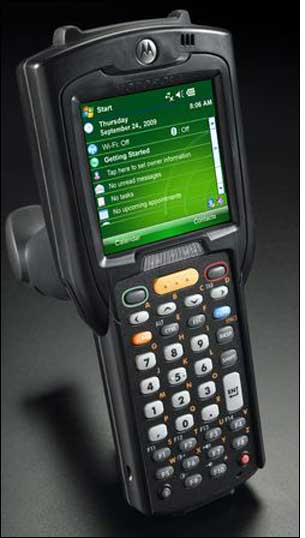Starting with its newest bar-code scanning handheld computers, the MC3100 series, Motorola will be embedding an RFID tag in the handle of every portable handheld computer model it releases. The tags will enable the company’s customers to use an RFID reader to determine each device’s location in a store’s backroom, or at a distribution center (DC). In this way, if a computer is misplaced, a handheld reader could be carried through a warehouse to locate the device—or , if someone takes a computer through an RFID portal installed at exit or dock doors, a user could be notified that it is leaving the premises.
The built-in EPC Gen 2 passive ultrahigh-frequency (UHF) tag is one of several features added to the MC3100 series, which became commercially available this month. The RFID tag was incorporated in response to the needs of consumers, says Sheldon Safir, a Motorola director of product marketing. The MC3100 follows the company’s MC3000 series, he says, of which 750,000 units have been sold since 2004. The device was built for scanning the bar-coded stock-keeping unit (SKU) numbers printed on products on the retail sales floor, or in a stock room or DC, for price or stock management, inventory control, returns processing, shipping and receiving, baggage tracking and asset management.
The MC3100 series was designed to be small and easy to use, Safir says. “Workers use it because it feels good in their hand,” he states. Although the size of the MC3000 made the device convenient to use, it was also easy to misplace. The newer version is intended to offer features that make it simpler to control. One concern users had expressed, Safir notes, was how to find the tool after it has been set down in a busy warehouse, or in a store’s backroom. Motorola addressed this problem by embedding an RFID tag into the handle of the MC3100 model.
To locate a misplaced computer, a person would need to walk around a site while holding a handheld RFID interrogator, such as Motorola’s MC9090-G RFID model. When the reader comes within read range of an MC3100 unit, it would read the ID number encoded in the computer’s tag. Typically, the read range of a UHF RFID tag within a warehouse environment is 10 to 20 feet, Safir says. However, he adds, read range performance can be further reduced if the MC3100 is placed on a metallic item. The MC3100 does not include an RFID reader itself, nor is there an add-on RFID interrogator available for the device—at least, not at present.The tag also could be used to prevent the handheld computer from being stolen or accidentally discarded. If a company’s site has EPC Gen 2 RFID portals installed at doorways, dock doors or cardboard-box crushers, the RFID readers at these portals would capture the MC3100’s tag ID number, and the company could configure its own RFID software to send an alert to management, indicating a handheld device is leaving the premises or has entered an unauthorized area.
Moreover, the tag could be used for analytics to, for instance, track how long a handheld device remains in a specific location—such as in a charger—as well as how long it was in use, thus enabling a company to track the device’s battery life, if the firm configured its own system to do so. Motorola does not provide software for MC3100 RFID-related applications.
The MC3100 series, with 128 megabytes of memory, operates on Microsoft’s Windows Mobile 6.X or Windows CE 6.0 operating systems, and an 802.11 Wi-Fi network card. Other features include the use of Motorola interactive sensor technology (IST)—a motion detector to determine when the device is in use, based on its movements, as well as when it is dropped. With the motion sensor, the MC3100 series devices can also switch to sleep mode when not in use, or if the display is lying face-down. An integrated accelerometer allows the display to rotate the direction of its images, based on how the device is being utilized.
All new features, Safir says, including the RFID tag, “are ultimately targeted at increasing efficiency and increasing productivity.”


